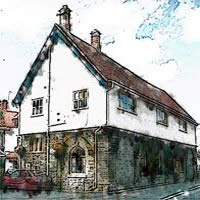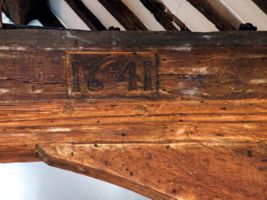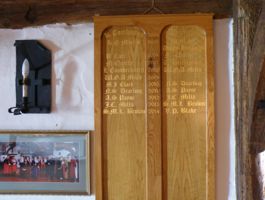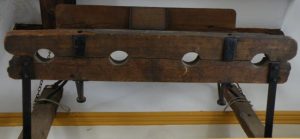

Alcester Town Hall History

In 1618 the Lord of the Manor of Alcester, Sir Fulke Greville III, provided the sum of £300 for the building of a market hall. Prior to that traders and customers would have gathered at a well and market cross which are likely to have occupied the same site.
Simon Whyte was appointed master mason. The limestone for the columns of the colonnade and the cornice carne from his own quarry at Chipping Campden; the remainder of the stone was Arden Sandstone, probably from Little Alne.
Originally the whole building was to have been constructed in stone but this was found to be too expensive. The timber-framed upper floor, with its magnificent roof, was constructed at the later date of 1641. Look for the date carved on one of the roof beams to the west side of the hall; it has recently been confirmed by tree-ring dating of the timbers.
The arches of the ground level were open, and all kinds of produce would have been traded using the space between the pillars, particularly those which needed shelter from the sun like cheese, or expensive goods such as silk which had to be kept out of the rain.
Sir Fulke’s manorial court, the Court Leet, checked the produce, charged traders and fined them if goods were not up to scratch. Upstairs, boards display the names of High and Low Bailiffs of the manor from 1299 to the present day.
 They also jailed offenders in the basement prison known as The Hole, which still exists today. Its massive oak door with iron bars is now on display in the main ground floor room. The cell was still in use as the town lock-up until about 1850 when a new police station opened in Henley Street.
They also jailed offenders in the basement prison known as The Hole, which still exists today. Its massive oak door with iron bars is now on display in the main ground floor room. The cell was still in use as the town lock-up until about 1850 when a new police station opened in Henley Street.
ln 1765, following a petition from townspeople, the Lord of the Manor Francis Greville, lst Earl of Warwick, revoked all market tolls payable to him on condition that the people of Alcester kept the hall in good repair. In the mid-19th century it housed the town’s fire engine.  In 1870 the roof was modified into the “hammerbeam” form seen today, although for a time it was concealed by a false ceiling. By this time the old market had ceased, so in 1873 the Marquess of Hertford (whose family had become Lords of the Manor in 1813) enclosed and converted the ground floor for use as the town’s magistrate’s court.
In 1870 the roof was modified into the “hammerbeam” form seen today, although for a time it was concealed by a false ceiling. By this time the old market had ceased, so in 1873 the Marquess of Hertford (whose family had become Lords of the Manor in 1813) enclosed and converted the ground floor for use as the town’s magistrate’s court.
The town stocks were stored here and are on display on the ground floor. They are of unusual design with four iron wheels, ready to be pushed outside through the streets of Alcester when required. Also on the ground floor, in a box attached to the ceiling, is a splendid hand-coloured Ordnance Survey map of 1887 showing the ancient manor of Alcester and surrounding parishes. Please view with great care when on display.
 During the Great War the hall was used as a hospital and in 1919 the town of Alcester raised £640 by public subscription to purchase the freehold of the hall from the 7th Marquess of Hertford. It was renamed The Alcester War Memorial Town Hall in memory of those who had given their lives for their country. A trust was set up naming the High and Low Bailiff of the manor during their term of office. They are still elected annually by male members of the community who are residents, leaseholders or freeholders in the manor. The ground floor was intended to be an institute and reading room, but this never happened.
During the Great War the hall was used as a hospital and in 1919 the town of Alcester raised £640 by public subscription to purchase the freehold of the hall from the 7th Marquess of Hertford. It was renamed The Alcester War Memorial Town Hall in memory of those who had given their lives for their country. A trust was set up naming the High and Low Bailiff of the manor during their term of office. They are still elected annually by male members of the community who are residents, leaseholders or freeholders in the manor. The ground floor was intended to be an institute and reading room, but this never happened.
In 1938 the hall received a gift of the coat of arms of the 2nd Marquess of Hertford, which now hangs above the upstairs fireplace. He married the Honourable Isabella Anne Ingram Sheppard in 1776 and the plaque shows how both family names were combined heraldically. In the same year, the false ceiling was removed exposing the timbers of the roof. The present fireplace and main stairs, in period style, were installed in 1939.
During the Second World War, the people of Alcester and surrounding nearby parishes raised £139,000 to commission the corvette, HMS Monkshood. You will find a model of the ship and ensign in the upper room. During the 1950s, a long series of improvements and repairs began, including a new oak floor upstairs. Major restorations have been carried out on the outside walls.
In 1978 a charitable trust and management committee was established and Mr. J Adams was appointed as the first chairman, a post he held until 2006. During this period an immense amount of work has been undertaken to preserve and improve the hall, including major alterations to the ground floor in 1985-6. In 1999 the committee welcomed the 9th Marquess of Hertford who succeeded his father as Patron and Lord of the Manor.